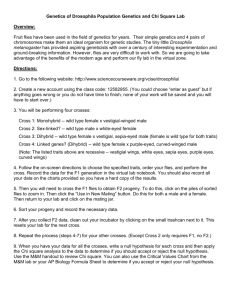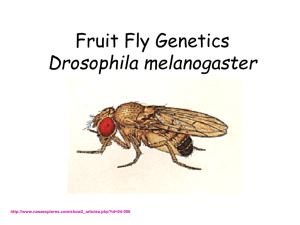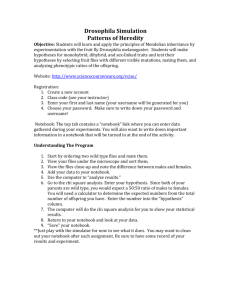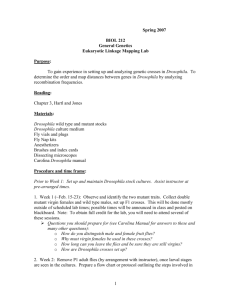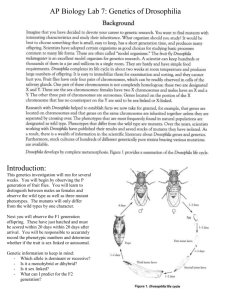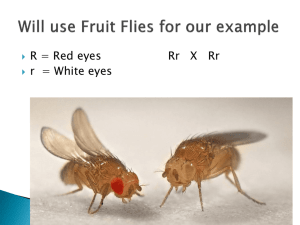Fruit Fly Genetics
advertisement
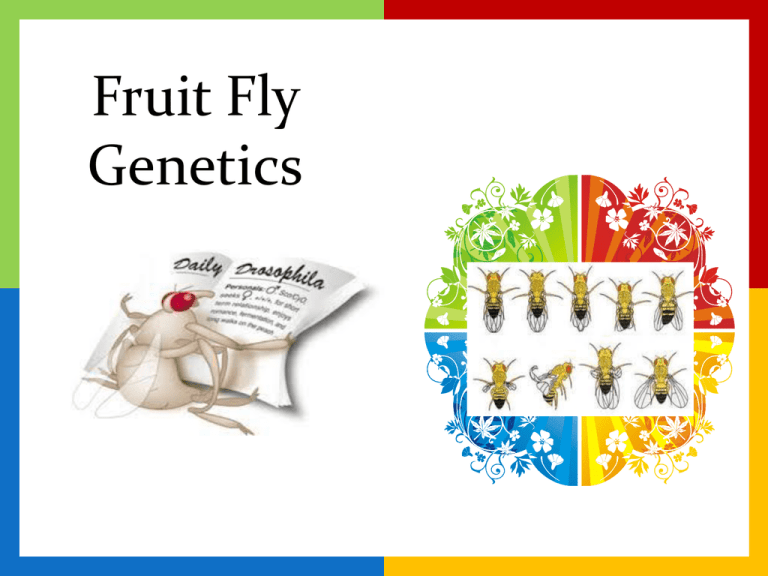
Fruit Fly Genetics Chromosome Theory of Heredity Found that genes are located on chromosomes Discovered Sex-Linkage Worked with Drosophila Nobel Prize for Physiology / Medicine in 1933. Thomas Hunt Morgan Why Drosophila? • • • • • Short Generation Time Easy to Maintain 4 large chromosomes Easily identifiable Markers (mutant phenotypes) CHROMOSOMES Female Male XX /XY ---Sex--- II III IV -----------Autosomal----------- Sex -chromosomes responsible for determining sex of an individual Autosomal- chromosome that is not directly involved in determining sex. Sexing adult flies Terminology: Phenotypes Wild type- the normal or most common phenotype in a population. Mutant Phenotype- traits that are alternates to the wild type. Changes due to mutations in the wild type. wt ebony white body Example Phenotypes Wild type Ebony body Vestigial wings Curled wings Wild type vs. ‘white eye’ phenotype WT White eye mutant Nomenclature Autosomal Genes (use + for wt allele) Use the following format when performing crosses: Genotype Phenotype +/+ vg / + wt (homozygous) wt (heterozygous) vg / vg +___ mutant wt (homozygous or heterozygous) Morgan suggested that this was due to an exchange of equal chromosome segments during synapsis in meiosis which he called crossing over. Autosomal Gene Nomenclature Wild-type genes located on autosomal chromosomes are donated “+” by convention (Each allele is represented and is seperated by a “/”) Genotype +/+ vg / + vg / vg Phenotype wt (homozygous) wt (heterozygous) mutant Monohybrid Cross Cross breeding organisms while tracking only one trait. Example Monohybrid Cross ++ (Wildtype) x vgvg (Vestigial) F1 Genotypes F1 vg vg + +vg +vg + +vg +vg Phenotypic Ratio: 4:4 wt Genotypic Ratio: 4:4 +vg We then cross two F1 progeny: +vg (heterozygous) x +vg (heterozygous) F2 Genotypes + vg + ++ +vg vg +vg vgvg F2 Phenotypic Ratio: 3 wt: 1 vg Genotypic Ratio: ¼ ++, 2/4 +vg, ¼ vgvg In a sex-linked cross, the principles are similar but the notation differs. Instead of showing the alleles on the X or Y chromosome, simply use the symbol for the gene that is on the X, for example: w+w+ is a female red-eyed fly. w≠ is a hemizygous white-eyed male. The (≠) denotes the Y chromosome, which in Drosophila carries only a few genes. Keep in mind that w+ is completely dominant to w, and that this is a case of complete sex-linkage. As an example of an X-linked cross , we will look at goggle-eye (unusually prominent eyes), an X-linked recessive trait (g) in Drosophila: As an example of an X-linked cross , we will look at goggle-eye (unusually prominent eyes), an X-linked recessive trait (g) in Drosophila: Example Dihybrid Cross ++/++ (Wild type) x bb/vgvg (Black vestigial) Dihybrid crosses involve manipulation and analysis of two traits controlled by pairs of alleles at different loci. For example, in the cross ebony body x vestigial wing e is ebony body color e+ is wild-type body colour vg is vestigial wing shape vg+ is wild-type wing shape: F2 F2 Morgan’s fruit flies… F1 Cambell, Reece, Taylor, Simon, and Dickey. Biology: Concepts and Connections, 6th edition. Benjamin Cummings Publishing. 2008. Morgan’s fruit flies… F2 Cambell, Reece, Taylor, Simon, and Dickey. Biology: Concepts and Connections, 6th edition. Benjamin Cummings Publishing. 2008. Virtual Lab Simulation: Drosophila Virtual lab – registration required (continue with silde show for instructions. Objective: Students will learn and apply the principles of Mendelian inheritance by experimentation with the fruit fly Drosophila melanogaster. Students will make hypotheses for monohybrid, dihybrid and sex-linked traits and test their hypotheses by selecting fruit flies with different visible mutations, mating them, and analyzing the phenotypic ratios of the offspring. Students will record their observations into an online notebook and write a lab report. Drosophila Simulation: Patterns of Heredity Last slide (read instructions first!) Click on the Drosophila Link for Registration 1. Create a new account 2. Class code (see last slide) 3. Enter your first and last name (your username will be generated for you) 4. Choose a password ' Write down your user name and passwords! Website: The top tab contains a "notebook" link where you can enter data gathered during your experiments. Also in the notebook tab, you will write your report. All notebook data and report data will be saved and sent to your teacher upon completion. Website’s Notebook: 1. Start by ordering two wild type flies and mate them. 2. View your flies under the microscope and sort them. 3. View the flies close-up and note the difference between males and females. 4. Add your data to your notebook. 5. Use the computer to "analyze results" 6. Go to the chi square analysis. Enter your hypothesis. Since both of your parents with wild type, you would expect a 50:50 ratio of male to females. You will need to you a calculator to determine the expected numbers from the total number of offspring you have. Enter that number in the "hypothesis" column. 7. The computer will do the chi square analysis for you and show your statistical results. 8. Return to your notebook and look at your data. **Just play with the simulator for now to see what it does. 9. "Save" your notebook. Understanding the Program Remove all your data from your notebook before you start the real assignments. For Assignment A (choose only one trait) Apterous Black Body Brown Eyes Curved Wings 1. Choose ONE trait from the autosomal mutations on the table to study by ordering flies of the mutant strain and crossing it with a wild type fly. 2. Cross your flies (P generation) and determine the phenotype of the F1 generation. 3. Now mate the offspring (F1) from that cross together (creates F2 generation). Return to the lab and choose "use fly in new mating" under the microscope view. 4. Sort your F2 flies and analyze results. You can choose to ignore sex here, since you know you are studying only autosomal mutations. Show that your results follow a 3:1 ratio. 5. Run a chi square analysis on your F2 flies (again you can ignore sex). Assignment A: MONOHYBRID CROSS 1. A reciprocal cross is a wild type male x mutant female followed by a mutant male x wild type female. (Obviously, you study the same trait here). Choose an allele found on the sex chromosome. [See chromosome map for sex linked alleles] 2. Show in your notebook how the offspring differ depending on which parent had the mutant phenotype. Be prepared to explain why this happens in your final lab report. You only need to look at the F1 generation here. Assignment B: SEX-LINKED TRAITS 1. Select any two traits on two different chromosomes and study their inheritance patterns (DIHYBRID CROSS) [See chromosome map] . Also be sure that you do not pick any traits that are LETHAL as this will skew your data. (a) Cross an F1 offspring with another F1 offspring to generate an F2 generation. This should demonstrate a 9:3:3:1 Mendelian ratio (b) (b) Test the 9:3:3:1 ratio by using a chi-square analysis. Assignment C: DIHYBRID CROSS Click: HERE http://www.sciencecourseware.com/vcise/drosophila/ If you are having difficulty, try this virtual lab: LabBench Activity: Genetics of Organisms email your results


